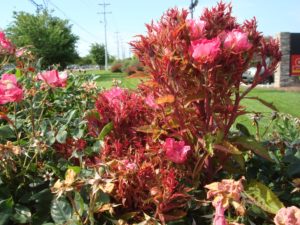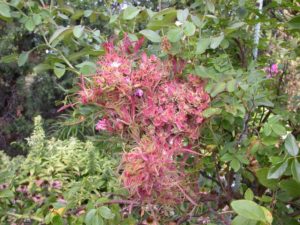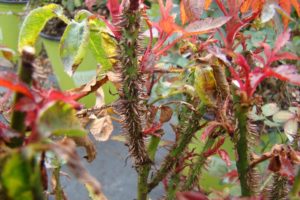Rose Rosette Disease
go.ncsu.edu/readext?689250
en Español / em Português
El inglés es el idioma de control de esta página. En la medida en que haya algún conflicto entre la traducción al inglés y la traducción, el inglés prevalece.
Al hacer clic en el enlace de traducción se activa un servicio de traducción gratuito para convertir la página al español. Al igual que con cualquier traducción por Internet, la conversión no es sensible al contexto y puede que no traduzca el texto en su significado original. NC State Extension no garantiza la exactitud del texto traducido. Por favor, tenga en cuenta que algunas aplicaciones y/o servicios pueden no funcionar como se espera cuando se traducen.
Português
Inglês é o idioma de controle desta página. Na medida que haja algum conflito entre o texto original em Inglês e a tradução, o Inglês prevalece.
Ao clicar no link de tradução, um serviço gratuito de tradução será ativado para converter a página para o Português. Como em qualquer tradução pela internet, a conversão não é sensivel ao contexto e pode não ocorrer a tradução para o significado orginal. O serviço de Extensão da Carolina do Norte (NC State Extension) não garante a exatidão do texto traduzido. Por favor, observe que algumas funções ou serviços podem não funcionar como esperado após a tradução.
English
English is the controlling language of this page. To the extent there is any conflict between the English text and the translation, English controls.
Clicking on the translation link activates a free translation service to convert the page to Spanish. As with any Internet translation, the conversion is not context-sensitive and may not translate the text to its original meaning. NC State Extension does not guarantee the accuracy of the translated text. Please note that some applications and/or services may not function as expected when translated.
Collapse ▲Rose rosette disease was first identified in the south in 1940. Known as a killer of both wild and cultivated roses, it wasn’t always considered to be a serious threat to cultivated roses. That all changed about 10 years ago when the incidence of the disease in home gardens began to rise rapidly.
Rose rosette has been identified as a virus and is transmitted by the tiny eriphyid mite. This mite travels on wind currents and when the wind dies down, it lands on whatever is handy. If it happens to be a rose bush of any kind, the virus will show itself shortly. It is being seen more and more frequently on cultivated roses and is also thought be caused by the use of infected graft buds.
The very popular Knockout rose has been particularly hard hit, probably because of the large numbers that have been planted in recent years, all across the U.S. This virus moves quickly through a planting.
There is no cure or control for rose rosette disease and gardeners should scout their roses vigilantly, watching for these symptoms: excessive thorniness, leaf stunting and deformation, thickening of stems, red coloration of shoots and “witches brooms”. Any infected plants should be bagged before digging and removed from the landscape as soon as possible. All nearby multiflora roses should also be removed.

Red Foliage & Witches Broom

Excessive Growth & Witches Broom

Excessive Thorns




